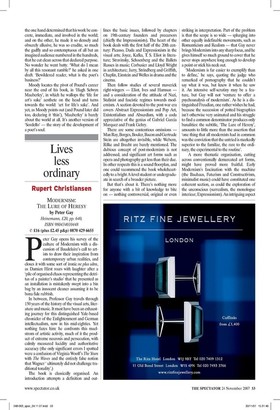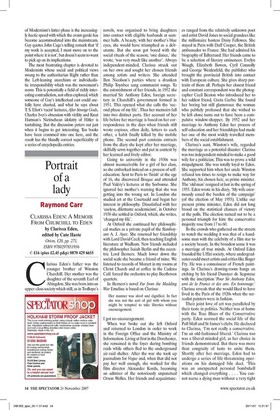Lives less ordinary
Rupert Christiansen MODERNISM: THE LURE OF HERESY by Peter Gay Heinemann, £20, pp. 640, ISBN 980434010448 £16 (plus £2.45 p&p) 0870 429 6655 peter Gay opens his survey of the culture of Modernism with a discussion of Baudelaire's call to artists to draw their inspiration from contemporary urban realities, and closes it with some sort of ironic ne plus ultra, as Damien Hirst roars with laughter after a 'pile of organised chaos representing the detritus of a painter's studio' that he presented as an installation is mistakenly swept into a bin bag by an innocent cleaner assuming it to be bona fide rubbish.
In between, Professor Gay travels through 150 years of the history of the visual arts, literature and music. It must have been an exhausting journey for this distinguished Yale-based chronicler of the Enlightenment and German intellectualism, now in his mid-eighties. Yet nothing fazes him: he confronts this maelstrom of artistic activity, much of it the product of extreme neurosis and persecution, with calmly measured lucidity and authoritative accuracy (the only significant errors I spotted were a confusion of Virginia Woolf's The Years with The Waves and the entirely false notion that Wagner' ultimately did not challenge traditional tonality'.) The book is classically organised. An introduction attempts a definition and outlines the basic issues, followed by chapters on 19th-century founders and precursors (chiefly the Impressionists). The heart of the book deals with the first half of the 20th century: Picasso, Dada and Expressionism in the visual arts; Joyce, Kafka, T. S. Eliot in literature; Stravinsky, Schoenberg and the Ballets Russes in music; Corbusier and Lloyd Wright in architecture; Jarry, Strindberg and Griffith, Chaplin, Einstein and Welles in drama and the cinema.
Then follow studies of several maverick right-wingers — Eliot, Ives and Hamsun — and a consideration of the attitude of Nazi, Stalinist and fascistic regimes towards modernism. A section devoted to the post-war era covers Abstract Expressionism and Pop Art, Existentialism and Absurdism, with a coda appreciative of the genius of Gabriel Garcia Marquez and Frank Gehry.
There are some contentious omissions — Man Ray, Borges, Boulez, Bacon and Gertrude Stein are altogether invisible, while Webern, Rilke and Brecht are barely mentioned. The dubious concept of post-modernism is not addressed, and significant art forms such as opera and photography get less than their due. In other respects this is a sound floorplan, and one could recommend the book wholeheartedly to a bright A-level student or undergraduate in search of a broader picture.
But that's about it. There's nothing more for anyone with a bit of knowledge to bite on — nothing controversial, original or even striking in interpretation. Part of the problem is that the scope is so wide — splurging into other equally indefinable movements, such as Romanticism and Realism — that Gay never brings Modernism into any sharp focus, and he gives himself so much ground to cover that he never stops anywhere long enough to develop a point or stick his neck out.
'Modernism is far easier to exemplify than to define,' he says, quoting the judge who remarked of pornography that he couldn't say what it was, but knew it when he saw it. An intensive self-scrutiny may be a feature, but Gay will not 'venture to offer a psychoanalysis of modernism'. As he is a distinguished Freudian, one rather wishes he had, because the succession of potted biographies isn't otherwise very animated and his struggle to find a common denominator produces only banalities: the subtitle, 'The Lure of Heresy', amounts to little more than the assertion that 'one thing that all modernists had in common was the conviction that the untried is markedly superior to the familiar, the rare to the ordinary, the experimental to the routine'.
A more thematic organisation, cutting across conventionally demarcated art forms, might have proved more fruitful. Early Modernism's fascination with the machine (the Bauhaus, Futurism and Constructivism, minimalist music) could have constituted one coherent section, as could the exploration of the unconscious (surrealism, the monologue interieur, Expressionism). An intriguing aspect of Modernism's latter phase is the increasingly hectic speed with which the avant-garde has become accommodated into the mainstream. Gay quotes John Cage's telling remark that 'if my work is accepted, I must move on to the point where it is not', but doesn't seem to want to pick up on its implications.
The most frustrating chapter is devoted to Modernists whose social and political views swung to the authoritarian Right rather than the Left-leaning anarchism or individualistic irresponsibility which was the movement's norm. This is potentially a field of richly interesting contradiction, not often explored, which someone of Gay's intellectual cast could usefully have charted, and what he says about T. S. Eliot's 'racist' lectures,After Strange Gods, Charles Ives's obsession with virility and Knut Hamsun's Nietzschean idolatry of Hitler is tantalising. But the discussion peters out just when it begins to get interesting. Ten books have been crammed into one here, and the result has the blandly correct superficiality of a series of encyclopedia entries.







































































 Previous page
Previous page